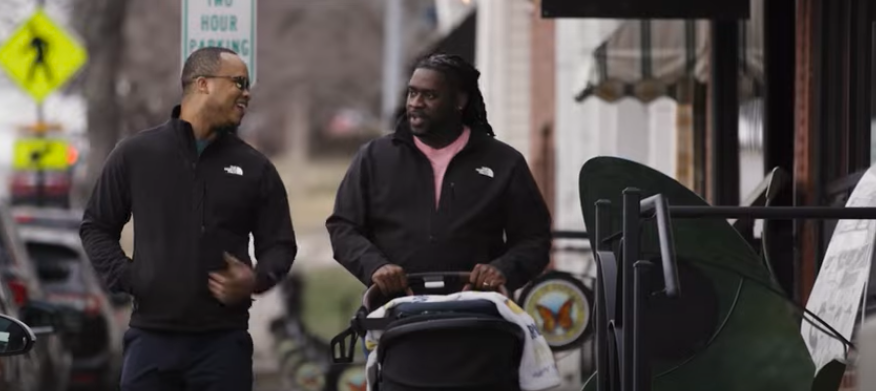“I don’t think people realize the sheer magnitude of the threat our community faces [in this political climate],” David Miller, producer of documentary We Live Here: The Midwest, tells GO over Zoom. We’re discussing the steadfast alt-right influence and fascist uptick in U.S. politics, a calculated effort that has ushered ultra-conservative, Evangelical Mike Johnson into the House Speakership. Those same efforts have introduced 500+ anti-LGBTQ+ bills in 2023 alone. We laughed through our anger as we spoke about the GOP political sphere, but true elation came about when we discussed Miller and We Live Here: The Midwest’s director, Melinda Maeker’s, inspiration for their recent film.
“Our documentary was born out of the backlash LGBTQ+ families experienced following the 2016 election, despite the passage of gay marriage,” Maeker says. Being in the LGBTQ+ community themselves, both Maeker and Miller expressed that, while they recognized Obergefell as tremendous, they also knew our right to marry wasn’t going to eradicate discrimination or lead to holistic equity. Maeker offers, “If anything, the passage of gay marriage made our community real to those who didn’t necessarily support us. When it wasn’t legal, they could ignore it, but now that isn’t an option.”
We Live Here: The Midwest follows a gay couple with an infant daughter in Nebraska, a lesbian couple raising their son in Kansas, a transfemme couple in Minnesota, a gay teacher and his husband in Ohio, and highschool sweethearts in Iowa who have parented their children and strengthened their marriage after one of them came out as a trans woman. These families are the epitome of visibility in places where many of those in power wish Bush’s “Don’t Ask, Don’t Tell” was still around– and didn’t just apply to the military.
During production, Miller and Maeker found that, understandably, “many of the LGBTQ+ families were reluctant to be interviewed…fear[ing] recrimination from their jobs, schools, and neighbors.” The reluctance and refusal of some makes the active visibility of others that much more sacred and crucial.
What is so often lost in LGBTQ+ discourse are the perspectives of those in our community who live outside of big cities like New York and Los Angeles. There are rural queers, transmasc farmers, and bisexual, nonbinary parents whose postal addresses might leave some of us big city queers scratching our heads. We might wonder why LGBTQ+ folks who are able to move to blue states and cities choose not to. After all, the overwhelming majority of the over 500+ anti-LGBTQ+ laws that have been introduced in 2023 originated in red states. But in our collective, communal action toward a safer, more equitable world for LGBTQ+ people, many of us still fail to recognize the fullness and potential of a queer life in rural or Midwest America. That’s why seeing real-life married couples like Courtney and Denise, living with their son in Kansas, in We Live Here: The Midwest is crucial to understanding the full scope of the queer American experience in places beyond queer cities.
“We do call them the flyover states,” David quips. But We Live Here: The Midwest intentionally touches down, so that LGBTQ+ people, allies, and even those who work to diminish our rights and lives are able to bear witness to the totality of queer and trans existence.
“We wanted to show these people living their real, everyday lives,” Miller says. “It was important to be able to show that these are people who are not much different from your own family.” The film also follows Monte and Mario, a Black gay married couple raising their infant daughter in Nebraska. Their neighbors, a white cis-heterosexual married couple, previously voted for Trump. On paper, the two couples sound like they might, at best, choose to only see each other through stolen glances through the blinds. On the contrary, they are close friends, expressing their deep love and admiration for each other on camera. This kind of platonic intimacy was both unexpected and exciting for Miller and Maeker. “I think people are often focused on their own needs when they’re voting,” Maeker says. “Sometimes, that means voting against other people.” But when you meet those “other people,” your perspective can shift. It’s their hope that the film gives credence to the power of changing one’s mind, to learning about, knowing, and even loving the people who are directly and negatively impacted by such votes.
Living in Los Angeles, Miller rarely gets a second glance when he’s walking down the street with his husband and their kids. And while Maeker has family in the Midwest, neither of the filmmakers knew about the everyday, nuanced experiences of LGBTQ+ Midwesterners previous to starting their recent project. Rightfully so, they assumed the vast majority of people might be in the same boat– with screens and souls impervious to the multifaceted realities of being a midwestern queer. Luckily, We Live Here: The Midwest unearths the stories of those who are often ignored, forgotten about, or flown right over.


What Do You Think?